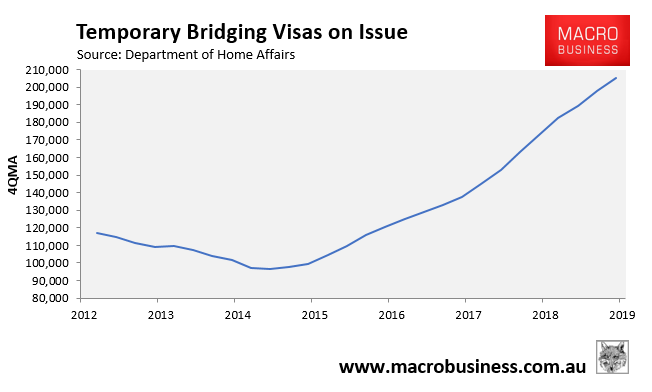Labor’s immigration spokesperson, Kristina Keneally, has once again lambasted the blowout of asylum seekers gaining entry into Australia by plane, which is being fuelled by so-called “criminal syndicates” and “people smugglers”:
[Keneally said] the Coalition’s fixation on the boats has allowed weakness to develop at airports – invoking, for example, the 81,596 people who have arrived by plane and claimed asylum since 1 July 2014. “Peter Dutton has failed to notice that criminal syndicates that people smugglers have shifted their business model from boats to planes,” she declared on Friday. Another question being pursued is whether Australia’s migration system is being used by criminal syndicates and labour hire companies to traffic exploited workers into Australia.
Immigration experts broadly support Kristina Keneally’s claims:
“Organised crime are indeed facilitating unlawful migration on a fee-for-service basis, using methodologies from fake identity documents, to gaming Australia’s visa system,” [John Coyne, the Australian Strategic Policy Institute’s head of border security] said.
“Australia’s border security arrangements are being exploited, and individuals who have not been appropriately identified are at times entering the country”…
Former deputy secretary of the department of immigration and border protection Abul Rizvi said the “eye watering” blowout in bridging visa numbers indicated a “sick system”.
“The people we’re talking about are generally vulnerable people. They will have little financial resources, and they are being exploited – they’re being exploited by criminals, and they’re being exploited by unscrupulous labour hire companies”.
Indeed, the best graphical representation of Kristina Keneally’s argument is the blow-out in bridging visas since the Coalition was elected in September 2013.
Bridging visas are generally handed to migrants awaiting decisions on applications for permanent residency. Therefore, they are a key indicator of the robustness and efficiency of Australia’s immigration system.
As shown in the next chart, there has been a near doubling of bridging visas under the Coalition’s watch, with 205,000 on issue as at June 2019, and the number surging by 29,400 over the past year alone:

Last week we received another prime example highlighting the systemic gaming of Australia’s visa system, with The ABC reporting that 33,000 Malaysians have traveled to Australia on tourist visas and attempted to claim asylum:
High Commissioner Andrew Goledzinowski said 33,000 Malaysians had applied for asylum in Australia in recent years, most of whom were thought not to be genuine refugees.
“Many who overstay then apply for refugee status. At the moment, we have 33,000 Malaysian citizens — not Syrians, not Rohingyas — who have applied as a refugee in Australia,” Mr Goledzinowski was quoted as saying.
“They are doing it because they know we are a generous country”…
More than 10,000 Malaysian nationals are estimated to be in Australia unlawfully — a significantly higher number than people from any other country…
Many of these Malaysians have also engaged the services of dodgy migration agents, as explained here.
With so many spurious claims for asylum, Australia’s Administrative Appeals Tribunal (AAT) has been placed under accute pressure and unable to cope with the case load. Hence, the blow-out in bridging visas, as noted by former High Court justice, Ian Callinan:
[Ian Callinan] said “almost everyone” with migration law experience had told him there were applicants and representatives who “game the system, well knowing there is an automatic entitlement to a bridging visa”…
The AAT now handles about 59,000 lodgements a year: more than half (52 per cent) are migration and refugee cases… The AAT’s caseload of migration and refugee matters doubled in the two years to June 30 last year…
The reality is that Australia’s border has become increasingly porous, with multiple pathways being established to game the visa system. These include, among other things:
- Migrants travelling to Australia on tourist visas and then attempting to claim asylum;
- Students studying ‘mickey mouse’ courses to obtain work rights and permanent residency;
- Criminal syndicates and illegal labour hire companies arranging undocumented migrants to work at below market rates; and
- Employers hiring migrant workers under the guise of fake ‘skills shortages’ to lower wage costs and undercut local workers.
The list goes on and is manifested in the chronic infrastructure pressures experienced across Australia’s cities, alongside the widespread prevalence of wage theft and Australia’s record low wage growth.

